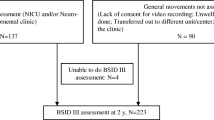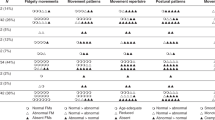Abstract
Background
A neurological assessment before discharge from the NICU would enable early targeted intervention to mitigate the risk and severity of cerebral palsy (CP) and neurodevelopmental disability.
Objective
To assess the accuracy of general movements (GM) in the preterm and fidgety movement periods in predicting neurodevelopmental disability and cerebral palsy in very preterm infants (≤32 weeks gestational age) at 18–24 months corrected gestational age.
Study design
Prospective cohort study
Participants
One hundred and seventy very preterm infants, mean (SD) gestation 29.8 (1.32) weeks, and birthweight 1215 (226) g.
Outcomes
Infants underwent GM assessments in the preterm period (31–36 weeks post-conception age) and fidgety movement period (8–18 weeks post term age). Neurodevelopmental outcomes were assessed in 127 children using the Griffiths Mental Developmental Scales-2.
Results
Nine children had neurodevelopmental disability (two infants with cerebral palsy and seven with global developmental delay. The relative risk (95% CI) for neurodevelopmental disability was 1.46 (0.31–6.89) with preterm movements and 6.07 (0.97–38.05) with fidgety movements. Sensitivity and specificity values for the prediction of neurodevelopmental disability were 33% and 64% in the preterm period and 25% and 92% in the fidgety movement period, respectively. The sensitivity and specificity values for prediction of CP were 50% and 63% in the preterm period and 100% and 93% in the fidgety movement period, respectively.
Conclusion
Preterm movements showed lower sensitivity and specificity than fidgety movements in predicting later CP and neurodevelopmental disability in preterm infants.
Similar content being viewed by others
References
Pascal A, Govaert P, Oostra A, Naulaers G, Ortibus E, Van den Broeck C. Neurodevelopmental outcome in very pre-term and very-low-birthweight infants born over the past decade: A meta-analytic review. Dev Med Child Neurol. 2018;60:342–55.
Novak I, Morgan C, Adde L, et al. Early, accurate diagnosis and early intervention in cerebral palsy: Advances in diag-nosis and treatment. JAMA Pediatr. 2017;171:897–907.
Prechtl HF. General movement assessment as a method of developmental neurology: New paradigms and their consequences. Dev Med Child Neurol. 2001;43:836–42.
Einspieler C, Prechtl HF. Prechtl’s assessment of general movements: A diagnostic tool for the functional assessment of the young nervous system. Ment Retard Dev Disabil Res Rev. 2005;11:61–7.
Einspieler C, others. Prechtl’s method on the qualitative assessment of general movements in preterm, term and young infants. Mac Keith Press London, UK; 2004.
Noble Y, Boyd R. Neonatal assessments for the preterm infant up to 4 months corrected age: A systematic review. Dev Med Child Neurol. 2012;54:129–39.
Spittle AJ, Doyle LW, Boyd RN. A systematic review of the clinimetric properties of neuromotor assessments for pre-term infants during the first year of life. Dev Med Child Neurol. 2008;50:254–66.
Manacero SA, Marschik PB, Nunes ML, Einspieler C. Is it possible to predict the infant’s neurodevelopmental out-come at 14 months of age by means of a single preterm assess- ment of general movements?. Early Hum Dev. 2011;88:39–43.
Kwong AKL, Fitzgerald TL, Doyle LW, et al. Predictive validity of spontaneous early infant movement for later cerebral palsy: A systematic review. Dev Med Child Neurol. 2018;60:480–9.
Stahlmann N, Härtel C, Knopp A, et al. Predictive value of neurodevelopmental assessment versus evaluation of general movements for motor outcome in preterm infants with birth weights <1500 g. Neuropediatrics. 2007;38:91–9.
Olsen JE, Brown NC, Eeles AL, et al. Trajectories of general movements from birth to term-equivalent age in infants born < 30 weeks’ gestation. Early Hum Dev. 2015;91:683–8.
Mukhopadhyay K, Malhi P, Mahajan R, Narang A. Neuro-developmental and behavioral outcome of very low birth weight babies at corrected age of 2 years. Indian J Pediatr 2010;77:963–7.
Milambo JPM, Cho K, Okwundu C, et al. Newborn follow-up after discharge from a tertiary care hospital in the Western Cape region of South Africa: A prospective observational cohort study. Glob Health Res Policy. 2018;3:1–7.
John HB, Oommen SP, Kumar M. Trajectories of general movements in very preterm infants: An experience from South India, a prospective cohort study. Current Medical Issues. 2022;20:16–21.
Griffiths R. Griffiths mental development scales extended revised manual. Firenze: Giunti Organizzazioni Speciali. 2006.
Oommen SP, Santhanam S, John H, et al. Neuro-developmental outcomes of very low birth weight infants at 18–24 months, corrected gestational age in a tertiary health centre: a prospective cohort study. J Trop Pediatr. 2019;65:552–60.
Mutlu A, Livanelioglu A, Korkmaz A. Assessment of general movements in high-risk infants by Prechtl analysis during early intervention period in the first year of life. Turkish J Pediatr. 2010;52:630–37.
Schoonjans F. MedCalc’s Diagnostic test evaluation calculator. MedCalc n.d. Accessed June 20, 2018. Available from: https://www.medcalc.org/calc/diagnostic_test.php
Kodric J, Sustersic B, Paro-Panjan D. Assessment of general movements and 2.5 year developmental outcomes: Pilot results in a diverse preterm group. Eur J Paediatr Neurol. 2010;14:131–7.
Albers S, Jorch G. Prognostic significance of spontaneous motility in very immature preterm infants under intensive care treatment. Biol Neonate. 1994;66:182–7.
Zahed-Cheikh M, Brévaut-Malaty V, Busuttil M, et al. Comparative analysis of perinatal and postnatal factors, and general movement in extremely preterm infants. Brain Dev. 2011;33:656–65.
Einspieler C, Marschik PB, Milioti S, Nakajima Y, Bos AF, Prechtl HFR. Are abnormal fidgety movements an early marker for complex minor neurological dysfunction at puberty? Early Hum Dev. 2007;83:521–5.
Bruggink JL, Einspieler C, Butcher PR, Van Braeckel KN, Prechtl HF, Bos AF. The quality of the early motor reper-toire in preterm infants predicts minor neurologic dysfunc-tion at school age. J Pediatr. 2008;153:32–9.
Groen SE, De Blécourt AC, Postema K, Hadders-Algra M. General movements in early infancy predict neuromotor development at 9 to 12 years of age. Dev Med Child Neurol. 2005;47:731–8.
Kwong AKL, Fitzgerald TL, Doyle LW, Cheong JLY, Spittle AJ. Predictive validity of spontaneous early infant movement for later cerebral palsy: A systematic review. Dev Med Child Neurol. 2018;60:480–9.
Acknowledgements
Dr Grace Rebekah, for her assistance with statistical analysis, Ms Indira Balan and Ms. Meenakshi Papanasam who helped in organizing follow up appointments for this study, and Mr Selvakumar G for his technical support.
Funding
Funding: Fluid Research Grant of Christian Medical College, Vellore
Author information
Authors and Affiliations
Contributions
Contributors: HB: conceptualized and designed the study, was involved in data collection and analysis, interpretation and conclusion, prepared and revised the manuscript; SPO, RS, LA: involved in study design, supervised data acquisition and analysis, interpretation of data and critical revision of the manuscript; STO: involved in data collection and critical revision of the manuscript. MK: involved in data acquisition and interpretation, guided and critically revised the final manuscript.
Corresponding author
Ethics declarations
Ethics clearance: IEC, Christian Medical College, Vellore; No. 8390, dated Sept 09, 2013.
Competing interests: None stated.
Additional information
Note: Additional material related to this study is available with the online version at https://www.indianpediatrics.net
Rights and permissions
About this article
Cite this article
John, H.B., Oommen, S.P., Swathi, T.O. et al. Preterm General Movements in Prediction of Neurodevelopmental Disability and Cerebral Palsy at Two Years: A Prospective Cohort Study. Indian Pediatr 59, 769–773 (2022). https://doi.org/10.1007/s13312-022-2619-x
Received:
Revised:
Accepted:
Published:
Issue Date:
DOI: https://doi.org/10.1007/s13312-022-2619-x




